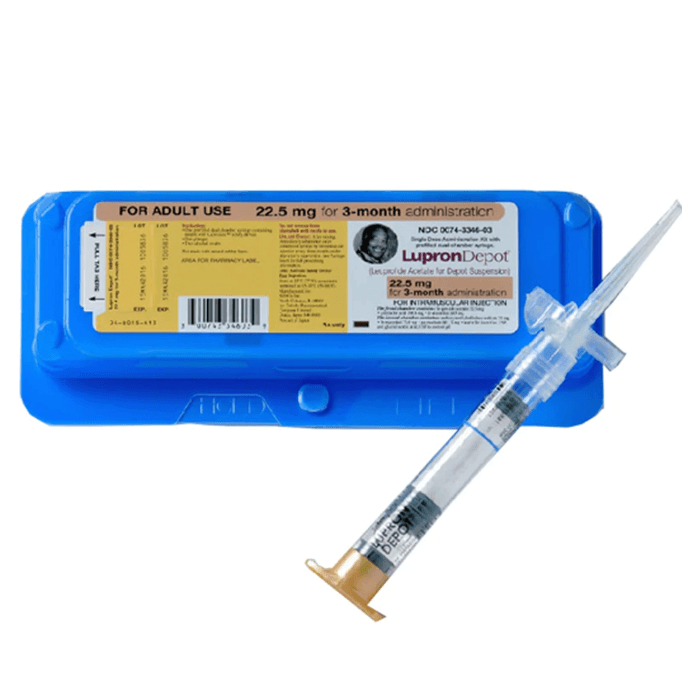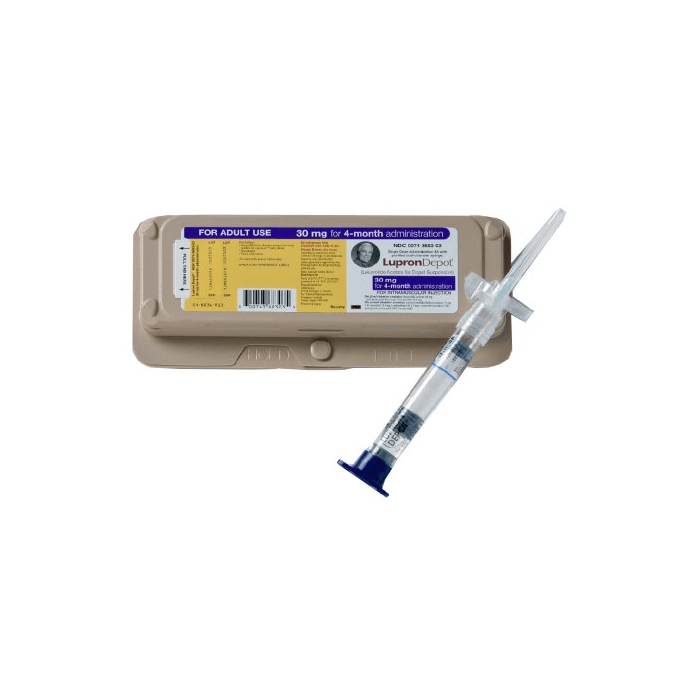Please note: a valid prescription is required for all prescription medication.
Lupron Depot® Injection for Prostate Cancer
Stock up and Save - Get 20% off when you buy 3 or more of any one product. Use code SAVE20 at checkout.
Coupon code cannot be combined with other offers. Sale applies to all products originating from Canada. Maximum allowable quantity equal to a 90 day supply per single order.
Price range: $532.99 through $2,014.99
Secure Encrypted Payments
Lupron Depot is a prescription injection used to reduce sex hormone production. It helps manage prostate cancer and certain gynecologic conditions. This page explains how it works, who it suits, and how to access US delivery from Canada, including options if you pay without insurance.
What Lupron Depot Is and How It Works
Lupron Depot® contains leuprolide acetate in a long-acting depot formulation. It acts on the pituitary to suppress luteinizing hormone, which lowers testosterone in men and estrogen in women. This reduction may slow hormone-driven disease activity. The kit is supplied for intramuscular dosing, typically administered by a trained professional.
YouDrugstore is a licensed Canadian pharmacy in Manitoba. Pharmacists review prescriptions before dispensing.
By reducing sex hormones, the treatment may relieve endometriosis pain, shrink fibroid size before surgery, and palliate advanced prostate cancer. Your prescriber determines the schedule based on indication, prior therapies, and monitoring needs.
Who It’s For
This medicine is used for adults with hormone-sensitive prostate cancer. It is also used for endometriosis and for preoperative management of symptomatic uterine fibroids. Pediatric formulations exist for central precocious puberty, but this listing is focused on adults. See our condition guides for Prostate Cancer, Endometriosis, and Uterine Fibroids.
Do not use during pregnancy. Use nonhormonal contraception while on treatment and for a period after the last dose, per label. Avoid if you have known hypersensitivity to GnRH agonists. People with severe osteoporosis risk, seizures, or heart rhythm disorders need careful evaluation.
Dosage and Usage
Administration is intramuscular, usually in a clinic setting. Typical schedules are monthly or every three months for adult indications. For prostate cancer, your clinician selects a regimen and monitors disease markers. A commonly used schedule for multi-month dosing includes Lupron Depot 22.5 mg. For endometriosis and fibroids, therapy is often limited in duration and may be combined with add-back therapy per label guidance.
General administration tips:
- Clinic dosing: prepared and injected by trained staff
- Stay on schedule: keep all appointments for injections
- Monitoring: labs and symptoms guide ongoing use
- Avoid missed doses: reschedule promptly if a visit is delayed
Because protocols vary, always follow the official label and your prescriber’s instructions.
Strengths and Forms
This is a long-acting, single-dose intramuscular depot supplied as a kit with powder and diluent. It is available in monthly and 3-month presentations, depending on market and indication. A widely used adult strength is Lupron Depot 3.75 mg. Availability can vary by supplier and jurisdiction.
Missed Dose and Timing
If an injection appointment is missed, contact your clinic for the next available visit. Do not double up early. The timing of the next dose depends on the schedule and your clinician’s judgment. Report any symptom changes while you wait for the rescheduled dose.
Storage and Travel Basics
Store the kit as directed on the package insert and keep it in the original carton. Protect from moisture and light, and keep out of reach of children and pets. Do not freeze. For travel, carry documentation and your prescription. Keep the carton with you rather than in checked baggage. If your clinic will administer the dose at destination, confirm storage requirements ahead of time.
Online orders require a prescription; it is verified before fulfilment. We use encrypted checkout for your privacy.
Pen Handling and Sharps Disposal
This therapy is not a self-injection pen. In most cases, a healthcare professional mixes and injects the suspension. If you handle used needles or vials, dispose of them in an approved sharps container. Do not place sharps in household trash or recycling. Follow local guidance for sharps drop-off or mail-back programs.
Benefits
As a GnRH agonist, the treatment can reduce hormone levels that drive symptoms or disease activity. For prostate cancer, lowering testosterone may help control progression and relieve related symptoms. For endometriosis, suppression of estrogen can lessen pelvic pain. In fibroids, preoperative use may decrease bleeding and help reduce uterine size for a planned procedure.
Side Effects and Safety
- Common effects: hot flashes, sweating, headache
- Mood and sleep: irritability or trouble sleeping
- Musculoskeletal: joint aches or bone pain
- Sexual health: decreased libido or erectile changes
- Gynecologic: vaginal dryness or bleeding changes
- Injection site: pain, redness, or bruising
Serious but less common risks include initial tumor flare in prostate cancer, spinal cord compression in those with metastases, severe allergic reactions, seizures, changes in blood sugar, and heart rhythm effects including QT prolongation. Report severe or sudden symptoms right away. If used with certain diabetes medicines or antiarrhythmics, extra monitoring may be needed.
Drug Interactions and Cautions
Tell your clinician about all medicines and supplements. Caution is advised with:
- Drugs that prolong QT: certain antiarrhythmics, macrolides, fluoroquinolones
- Seizure threshold–lowering agents: some antidepressants, bupropion, tramadol
- Systemic corticosteroids: may affect bone health
- Antidiabetic agents: glucose changes can require closer follow-up
Bone density may decline with extended use. Your care plan may include calcium, vitamin D, lifestyle measures, or add-back therapy when appropriate. Always defer to the approved product label for complete interaction information.
What to Expect Over Time
Some people notice a short-term symptom change at the start of therapy due to the mechanism of action. Over subsequent weeks, hormone levels typically decline with consistent dosing. Your clinician will track symptoms, physical findings, and lab results. Keeping appointments and sharing updates helps adjust the plan if needed. If you experience new or worsening symptoms, contact your healthcare professional.
Compare With Alternatives
Other options may be considered based on diagnosis and goals. An oral GnRH antagonist such as Orgovyx® is used in certain prostate cancer settings and avoids an initial hormone surge. For nonmetastatic disease, an androgen receptor inhibitor like Nubeqa® may be part of a broader plan. Your prescriber will compare mechanisms, dosing, and monitoring needs.
For context on other GnRH therapies and costs, see our overview article Zoladex Cost Usage Side Effects. If you are exploring fertility protocols, this background piece may help: How Does Lupron Work During Ivf.
Pricing and Access
We list transparent options so you can compare depot schedules and Canadian pricing. Many customers review cash-pay details before deciding. If you are researching Lupron Depot price, check the product page for current information. For those comparing Lupron Depot cost, we display options that align with common dosing intervals.
You can review our Promotions page for any current site offers. We support US shipping from Canada with clear checkout steps and prescription verification.
Availability and Substitutions
Stock status can vary by presentation and supplier. If a preferred presentation is unavailable, your prescriber may recommend an alternative product or schedule. For broader market context, some patients also look at Leuprorelin Depot price discussions when weighing options. We cannot provide restock dates, but our team updates availability as soon as it changes.
Patient Suitability and Cost-Saving Tips
Good candidates are those with hormone-driven conditions where suppression is indicated and monitoring is feasible. People with severe, uncontrolled cardiovascular disease, high fracture risk, or active pregnancy are generally not candidates. Discuss your medical history and goals with your prescriber to decide on the best plan.
To help manage out-of-pocket costs, consider longer-interval dosing when clinically appropriate, setting refill reminders, and coordinating clinic appointments in advance. Some patients compare Leuprolide Depot price across schedules to plan their budget. If you pay cash, ask your clinic about administration fees so you understand the full visit charges. Bringing your kit to the appointment can also streamline care.
Questions to Ask Your Clinician
- Goals and timeline: what outcomes are realistic for my condition?
- Dose schedule: monthly or multi-month, and why?
- Monitoring: what tests will track response and safety?
- Bone health: how will we protect my bone density?
- Flares: how will symptom flare be managed at initiation?
- Contraception: what nonhormonal method should I use?
- Alternatives: which other options fit my case and coverage?
Authoritative Sources
FDA Prescribing Information (Leuprolide Acetate Depot)
Health Canada Drug Product Database
Ready to proceed? You can upload your prescription and complete checkout for this therapy with prompt, express, temperature-controlled handling when required. Ships from Canada to US. This information is not a substitute for medical advice; always follow your prescriber and the approved label.
Express Shipping - from $25.00
Shipping with this method takes 3-5 days
Prices:
- Dry-Packed Products $25.00
- Cold-Packed Products $35.00
Shipping Countries:
- United States (all contiguous states**)
- Worldwide (excludes some countries***)
Standard Shipping - $15.00
Shipping with this method takes 5-10 days
Prices:
- Dry-Packed Products $15.00
- Not available for Cold-Packed products
Shipping Countries:
- United States (all contiguous states**)
- Worldwide (excludes some countries***)
How does this depot therapy work in the body?
This medicine is a GnRH agonist. It initially stimulates, then downregulates pituitary receptors. Over time, luteinizing hormone falls, and sex hormone levels drop. In prostate cancer, lower testosterone helps reduce disease activity. In endometriosis and fibroids, estrogen suppression can lessen symptoms. Your clinician may monitor labs and symptoms to guide ongoing use. The first weeks can feel different as the body adjusts to the mechanism.
How is the dosing interval selected?
Your prescriber chooses a monthly or multi-month depot based on the indication, prior treatments, convenience, and monitoring needs. Clinic logistics and appointment availability may factor in. For gynecologic uses, the total course is often limited. For prostate cancer, ongoing therapy is common, guided by symptom control and laboratory markers. If your situation changes, the schedule can be reassessed at a follow-up visit.
Can this treatment cause an initial symptom flare?
At initiation, GnRH agonists can trigger a brief hormone surge. Some people with advanced prostate cancer may notice a temporary increase in symptoms before suppression occurs. Your clinician may use supportive measures to manage this period. If you experience sudden pain, weakness, or neurological changes, seek medical attention promptly. The care team will advise on strategies to minimize discomfort and risk.
What contraception should be used during therapy?
Use nonhormonal contraception during treatment and for a period after the last dose, as directed on the label. Hormonal methods can counteract the medicine’s purpose. Barrier methods are commonly recommended. Discuss the timeline with your prescriber, especially if you plan surgery or fertility treatments. Tell your healthcare professional if you become pregnant or plan to conceive.
Can I switch from another GnRH medicine to this one?
Switching between GnRH therapies may be considered when guided by your clinician. They will review the current regimen, indication, disease control, and side effects. Timing matters to avoid gaps in suppression. Monitoring will continue after the change to confirm stability. Do not stop or switch on your own; always coordinate the plan and the first injection on the new schedule with your clinic.
How is bone health managed during longer courses?
Androgen or estrogen suppression can reduce bone mineral density. Your clinician may order a baseline and follow-up bone density test. Calcium, vitamin D, weight-bearing activity, and limiting alcohol and tobacco can help. In some cases, add-back therapy or other medicines may be considered. Discuss personal fracture risk, especially if you have a history of osteoporosis or long-term steroid use.
Who prepares and injects the dose?
Most patients receive injections in a clinic. A nurse or trained professional mixes the suspension and administers it intramuscularly. If your clinic asks you to bring the kit, keep it in the original packaging and follow storage instructions on the carton. After use, sharps are placed in an approved container. If you have concerns about timing or technique, speak with your care team beforehand.

